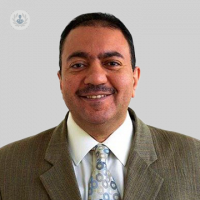Clear lens extraction: A comprehensive solution
Written by:Cataracts, a common age-related condition characterised by the clouding of the eye's natural lens, pose significant challenges to clear vision and daily functioning. While cataract surgery has long been the standard treatment, Clear Lens Extraction (CLE) has emerged as a versatile option that not only addresses cataracts but also provides an opportunity for refractive correction. In his latest online article, Mr Mohamed El-Ashry explores the intricacies of CLE, its benefits, and considerations for those considering the procedure.

Understanding cataracts:
Cataracts develop gradually over time, resulting in symptoms such as blurred vision, sensitivity to light, and difficulty distinguishing colours. The condition primarily affects older individuals but can also be influenced by genetic predispositions, lifestyle factors, and environmental exposures. As cataracts progress, they can significantly impair vision and quality of life, necessitating intervention to restore clarity and functionality to the eye.
The evolution of treatment:
Historically, the treatment of cataracts has evolved from simple attempts at removal to sophisticated surgical techniques aimed at replacing the clouded lens with an artificial intraocular lens (IOL). With advancements in technology and surgical methods, cataract surgery has become one of the most common and successful procedures performed worldwide, offering significant improvements in visual acuity and quality of life for millions of individuals. However, the traditional approach to cataract surgery primarily focuses on removing the clouded lens without addressing underlying refractive errors, such as near-sightedness, farsightedness, or astigmatism, which may coexist with cataracts and impact visual outcomes.
Clear lens extraction: How it works:
Clear lens extraction (CLE), also known as refractive lens exchange or lens replacement surgery, represents a modern and comprehensive approach to addressing both cataracts and refractive errors simultaneously. During CLE, the eye's natural lens is surgically removed and replaced with an artificial intraocular lens customised to the patient's individual visual needs. The procedure is similar to traditional cataract surgery but is performed before significant lens opacity develops, offering the added benefit of refractive correction.
Benefits of Clear Lens Extraction:
One of the primary advantages of CLE is its ability to correct refractive errors, such as near-sightedness, farsightedness, and astigmatism, in addition to treating cataracts. By replacing the eye's natural lens with an artificial intraocular lens, CLE can reduce or eliminate the need for glasses or contact lenses following surgery, providing patients with greater freedom and clarity of vision. Moreover, CLE offers predictable and stable visual outcomes, with many patients experiencing improved visual acuity and enhanced quality of life following the procedure. Additionally, CLE can be performed on individuals who may not be suitable candidates for other vision correction procedures, such as LASIK or implantable collamer lenses (ICLs), making it a versatile option for a wide range of patients.
Considerations for Clear Lens Extraction:
While CLE offers numerous benefits, it is essential for patients to consider the potential risks and limitations associated with the procedure. Like any surgical intervention, CLE carries inherent risks, including infection, inflammation, retinal detachment, and dissatisfaction with visual outcomes. Additionally, CLE may not be suitable for patients with certain pre-existing eye conditions, such as glaucoma or macular degeneration, or those with unrealistic expectations regarding the procedure's outcomes. Therefore, it is crucial for patients to undergo a thorough pre-operative evaluation and consultation with an experienced ophthalmologist to determine their candidacy for CLE and to discuss any concerns or questions they may have regarding the procedure.
Mr Mohamed El-Ashry is an esteemed ophthalmologist. You can schedule an appointment with Mr El-Ashry on his Top Doctors profile.


